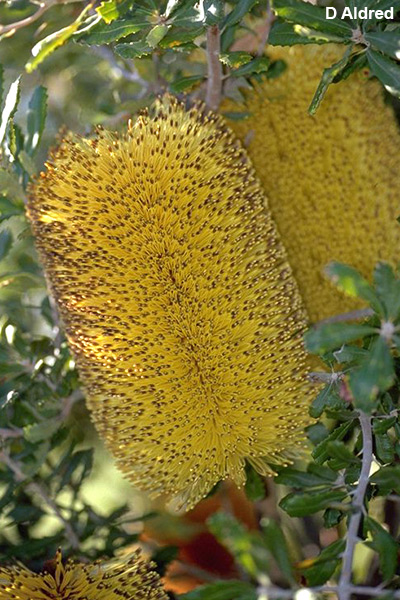General Description:
Banksia epica was officially named in 1987 and has only recently been cultivated. In nature, it exists as a taller inland shrub to 2.5 metres by 3 metres across, or as a coastal form which reaches 1.5 metres or so. It can be distinguished from the closely-related Banksia media by its smaller leaves, which are 6-15mm wide and 15-50mm long and obovate, truncate. Flower spikes begin as bright green and develop to an all yellow or yellow with grey pollen presenters. They further mature to a pale yellow inflorescence 20-22 cm tall and 10-12 cm wide. Flowering occurs in autumn through to early spring. The seeds are enclosed in follicles attached to a woody cone and are generally retained within the cone until burnt.
In nature, Banksia epica grows on sandy alkaline soils on limestone cliffs at Point Culver and Toolinna Cove on the western coastline of The Great Australian Bight. Cultivation of this species has been pioneered by Kevin Collins of the Banksia Farm in Albany, Western Australia, where it has been grown in loamy clay or sandy gravel. Under these conditions the species has proven very tolerant to alkaline soils (pH ranging from 6 to 9). It has also succeeded in alkaline, sandy soils of the Kwinana to Mandurah region south of Perth close to the coast where most other banksias struggle.
Banksia epica has also been grown to flowering in very well drained beds at the Australian National Botanic Gardens in Canberra. Its hardiness to east coast conditions is otherwise unknown as yet but may be worth trialing given the hardiness of its close relative B.media.
Propagation is by seed or cuttings.
* EPBC Act = Environment Protection and Biodiversity Conservation Act 1999;
ROTAP = Rare or Threatened Australian Plants (Briggs and Leigh, 1988)
For further information refer the Australian Plants at Risk page

Banksia epica
Photo: David Aldred
 Australian Native Plants Society (Australia)
Australian Native Plants Society (Australia)